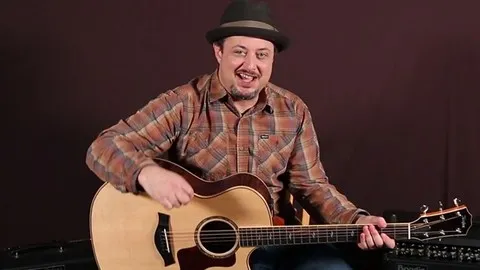
Free Acoustic Guitar Tutorial - Beginner Strumming 15-Video Digital Course 
This 15-video digital course is designed to help beginners learn the basics of acoustic guitar strumming. Learn easy strum patterns, tips for "locking in" your strumming, and how to use arpeggios. Move on to more advanced strum patterns and learn how to commit them to muscle memory. Add sophistication and texture to your strumming and use "liquid chords" to create a fast and flowing sound. With this course, you can learn to strum rhythmically and musically with ease. ▼
ADVERTISEMENT
Course Feature
![]() Cost:
Cost:
Free
![]() Provider:
Provider:
Udemy
![]() Certificate:
Certificate:
No Information
![]() Language:
Language:
English
![]() Start Date:
Start Date:
Self Paced
Course Overview
❗The content presented here is sourced directly from Udemy platform. For comprehensive course details, including enrollment information, simply click on the 'Go to class' link on our website.
Updated in [May 25th, 2023]
This 15-video digital course is designed to help beginner guitarists learn the basics of acoustic guitar strumming. Through this course, students will learn easy strum patterns, tips for "locking in" their strumming, and how to use arpeggios in a variety of ways. As students progress, they will learn more advanced strum patterns and how to commit them to muscle memory. Additionally, they will learn how to add sophistication and texture to their strumming to take it to the next level. Finally, they will learn how to use "liquid chords" to create a fast and flowing sound that they and others will enjoy hearing.
[Applications]
The application of this course can be seen in the ability to learn and apply various strum patterns, arpeggios, and other techniques to acoustic guitar playing. With the help of this course, users can learn to strum rhythmically and musically with ease, as well as commit their new strumming abilities to muscle memory. Additionally, users can learn to add sophistication and texture to their strumming to take it to the next level, as well as use "liquid chords" to create a fast and flowing sound.
[Career Paths]
1. Acoustic Guitar Teacher: Acoustic guitar teachers are responsible for teaching students how to play the acoustic guitar. They typically provide instruction in the basics of playing the instrument, such as chords, scales, and strumming patterns. They may also provide more advanced instruction in music theory, improvisation, and composition. As the popularity of acoustic guitar continues to grow, the demand for acoustic guitar teachers is expected to increase.
2. Acoustic Guitar Performer: Acoustic guitar performers are responsible for playing the acoustic guitar in a variety of settings, such as concerts, festivals, and other live events. They must be able to play a variety of styles, such as folk, blues, jazz, and classical. As the popularity of acoustic guitar continues to grow, the demand for acoustic guitar performers is expected to increase.
3. Acoustic Guitar Technician: Acoustic guitar technicians are responsible for maintaining and repairing acoustic guitars. They must be knowledgeable in the construction and repair of acoustic guitars, as well as the various components of the instrument. As the popularity of acoustic guitar continues to grow, the demand for acoustic guitar technicians is expected to increase.
4. Acoustic Guitar Composer: Acoustic guitar composers are responsible for writing and arranging music for the acoustic guitar. They must be knowledgeable in music theory and composition, as well as the various techniques used to play the instrument. As the popularity of acoustic guitar continues to grow, the demand for acoustic guitar composers is expected to increase.
[Education Paths]
1. Bachelor of Music: This degree path is designed to provide students with a comprehensive understanding of music theory, composition, performance, and production. Students will learn how to read and write music, as well as develop their skills in playing instruments and producing music. This degree path is becoming increasingly popular as technology advances and the music industry continues to grow.
2. Bachelor of Arts in Music: This degree path focuses on the history and culture of music, as well as the fundamentals of music theory and composition. Students will learn about the development of music throughout history, as well as the different genres and styles of music. This degree path is becoming increasingly popular as more people are interested in learning about the history and culture of music.
3. Master of Music: This degree path is designed for those who want to specialize in a particular area of music. Students will learn advanced music theory, composition, and performance techniques. This degree path is becoming increasingly popular as more people are interested in pursuing a career in music.
4. Master of Arts in Music: This degree path focuses on the history and culture of music, as well as the fundamentals of music theory and composition. Students will learn about the development of music throughout history, as well as the different genres and styles of music. This degree path is becoming increasingly popular as more people are interested in learning about the history and culture of music.
Course Syllabus
Learn some common strumming patterns to help you develop your rhythm.
Learn a fairly easy rhythm using what Marty calls the "Super G."
Here you'll learn to master another simple strumming pattern. By adding new pat
The strum pattern you learn in this video builds off the previous lesson by addi
Learn another useful and easy strum pattern to use in various songs. The E Mino
You'll learn a straightforward strum pattern with a simple twist added — you'll
Here we speed up the strum pattern a bit with some chords mixed in. You'll alre
Now you'll learn how to break up your strum patterns with arpeggios. This is wh
In this video, you'll learn a picking pattern with single notes again in the sty
Here you'll learn a commonly used strum pattern that is one of the most valuable
In this video you'll learn how to add special effects to your strum patterns. T
Here you'll learn the popular technique known as palm muting, which is a nice “d
Learn yet another strum pattern, this one a little "sadder" in tone. Learning t
Here you'll learn another strum pattern, but time using a triplet, which is thre
Here Marty passes along some valuable advice in conclusion. Among other things,
Pros & Cons

Brilliant strumming patterns.

Easily explained.

Great intro to strumming patterns.

Clear and easy to understand.

Very helpful course.

No theory part explained.

Requires patience and discipline.

Not suitable for advanced learners.

Limited options when course ends.

Not enough information provided.
Course Provider

Provider Udemy's Stats at AZClass
Discussion and Reviews
0.0 (Based on 0 reviews)
Explore Similar Online Courses

Java Programming Basics

Real Time Chat With Laravel Broadcast Pusher and Vuejs

Python for Informatics: Exploring Information

Social Network Analysis

Introduction to Systematic Review and Meta-Analysis

The Analytics Edge

DCO042 - Python For Informatics

Causal Diagrams: Draw Your Assumptions Before Your Conclusions

Whole genome sequencing of bacterial genomes - tools and applications

Master Guitar In 90 Days: Step-By-Step Lessons For Beginners

Acoustic Blues Guitar Lessons : Learn Blues Guitar

Learn How to Improvise on Guitar in 30 Days
 Related Categories
Related Categories
 Popular Providers
Popular Providers
Quiz
 Submitted Sucessfully
Submitted Sucessfully
1. What is the main focus of this course?
2. What is the goal of this course?
3. What type of sound will you learn to create?


Start your review of Free Acoustic Guitar Tutorial - Beginner Strumming 15-Video Digital Course